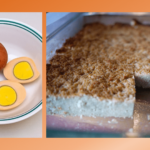With the specific history of Jews in the Arab world, particularly in the latter half of the 20th century, but also over the preceding century, it is easy to overlook the fact that masses of Jews lived throughout the Middle East for millennia. This is of course reflected in the third major classification category of Jews, afer Ashkenazi and Sephardi: Mizrachi. (As you may know, however, one of my pet peaves is that even these three categories do not sufficiently categorize all Jewish communities, and I’d much rather we don’t try to separate our people by just putting them into boxes.)
When we use the term Mizrachi (literally “eastern,” as seen in relation to Israel), we are referring to those Jews who had stronger connections to the ancient Jewish hub in Mesopotamia. In classical Jewish texts we refer to that region as Bavel (Babylonia). We’re talking about the area that is today largely in Iraq. And in fact, the t’bit in this post’s title is an Iraqi Jewish food.
T’bit, Chulent, and Hamin

Many of you may be familiar with chulent or hamin, the primary versions of this dish respectively made by Ashkenazi or Sephardi Jews. But there are many many more iterations (otherwise, I’d have a hard time writing an entire book on the subject). T’bit, the Iraqi type of Shabbat stew, is one of the more identifiable and distinctive versions. (Making matters a bit confusing, the spelling of the dish’s name is not standardized. You will sometimes see it spelled tebit, tabeet, tabyeet, or in any number of other ways. To be fair, the same is true, though less so, of other transliterated names; cholent, chunt, tzolent, chamin, hameen, and chamim are also popular spellings of those two dishes.)
For starters, there are many fewer core ingredients in t’bit. Typically it is made with just rice and chicken, occasionally with the addition of onions or perhaps a layer of thinly sliced potatoes at the bottom. Rarely, you may also find crushed tomatoes, or tomato paste included as well. (These last two are more recent innovations, as potatoes and tomateos are New World foods, and were not eaten in the region for centuries even after the start of the Columbian Exchange.) Beyond that, there are typically no other vegetables, and no legumes of any kind.
Flavorings in a T’bit come instead from an aromatic spice blend, and from the chicken’s giblets — the chicken’s gizzard, liver, heart, etc. The blend, known as baharat, simply means “spices” in Arabic, so there are many variations. (Similarly, in other parts of the world, you find other spice blends that vary from version to version, such as Moroccan ras el hanut or Yemenite hawaij.) Common ingredients in the baharat blend include cardamom, cinnamon, allspice, black pepper, and more. Beyond the spices and organ meats, however, the taste of a t’bit naturally derives from the slow-cooked rice-and-chicken combo.
The most distinctive element of a t’bit, however, is the way the whole thing is assembled. Some of the spiced rice is mixed with the giblets and stuffed inside the whole chicken, and that that is buried, or at least surounded, by even more rice. You thus get two different types of rice, one from the inside that is moister and has picked up the flavor of the chicken fat as well, and a drier and crispier version from the outside. This mix of two type of rice is a beloved element in this Iraqi stew.
Nowadays, most cooks opt for the convenient method of simply filling the cavity of a whole chicken, but previously the preparation was more elaborate and complex. The cook would remove the central carcass of the chicken — meat and bones together — from within the skin, taking care to keep the skin whole and untorn. (Typically, the wings and legs were left in place.) Then the chicken flesh was removed from the carcass, mixed with the rice and giblets, and then stuffed back into the skin, refilling it. This meant even more space inside was filled with the mixture, since the inedible bones had been removed. (It is hard to see in the picture above — and frankly it isn’t the best picture, so I apologize — but it looks like that cook may have used the old-fashioned method.)
What Ties T’bit to Other Jewish Foods
As idiosyncratic and recognizable as t’bit is, it still bears striking similarities to many other Jewish foods. Other Shabbat stews, of course, but even other popular traditional dishes. For starters, virtually all Shabbat stews feature at their core a combination of a grain and a meat. An Ashkenazi chulent typically has barley and beef. A hamin, at times, might use wheat and lamb instead. In this case, rice and chicken fill those two roles. (In the book I discuss reasons why the most popular grains and meats in each region were selected, but you’ll have to wait for it to come out to read about that!) In fact, the most likely candidate for the original Shabbat stew contained little more than wheat and lamb, pounded into a porridgy consistency.

Beyond that, Jews around the world have historically been offal eaters. From chopped liver to stuffed spleen to Yemenite lamb-foot soup to brain fritters, Jews have typically consumed almost all edible parts of the animals they slaughtered. Among other things, this reflects the value of bal tashchit — not to waste usable things, including edible things. So the inclusion of the chicken giblets is very much in line with this idea.
Furthermore, the idea of stuffing the skin of the chicken after removing the bones, and creating a more substantial dish largely made up of (less expensive) grain is actually the origin of a dish that is more familiar to Jews today. I’m talking here about gefilte fish! The name of the food actually reveals this: “gefilte” literally translates to filled, or stuffed. Originally, the fish was removed from its skin, flesh peeled from the bones, and then chopped and stretched with an inexpensive grain (flour) to be then stuffed back into the fish skin. Sound familiar?
So, while t’bit is unique in the realm of Shabbat stews, this truly beloved Iraqi-Jewish comfort food is also tied to other versions of that stew, and other popular Jewish foods in general. Once again, an example of the Jewish people’s unity within its diversity!
Be Kind. Please Rewind. (Or rather, pass along to another Jewish Food fan.)






